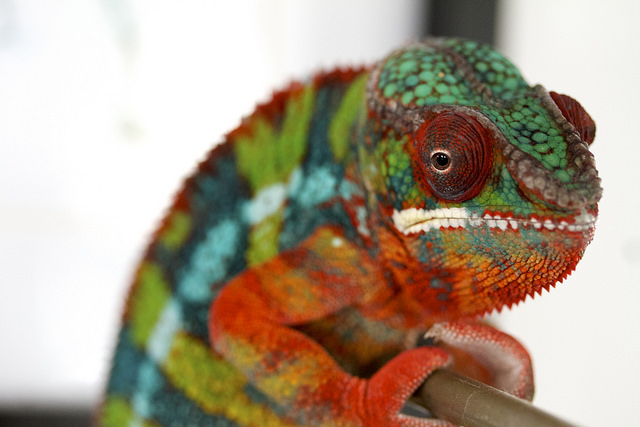Dear Jasmine and Marie,
There’s something about a chameleon’s darting eyes, long tongue, curled tail, and ability to climb that makes it a fascinating animal to watch. Especially when it’s changing colors.
And the latest research on your question suggests that how a chameleon changes has more to do with light than scientists once thought.
That’s what I learned from my friend Paul Verrell, a biologist at Washington State University who studies animal behavior and works with reptiles. He said not all chameleons change colors. They also don’t necessarily use their colors to hide from predators. Since many are green, they often naturally blend in with plants in their environment. Instead, changing colors can help chameleons maintain their temperature or communicate that they’re interested in a mate.

“The big question is, how can chameleons change their colors so hugely, sometimes in very short periods of time?” Verrell said. “Well, let’s think of a different animal that can change its color. Octopuses are very famous for being able to change their color. They can change their color according to their moods.”
If we zoom into the cells that make up octopus skin we find tiny particles, called pigments, that give them their natural color. Depending on whether those pigments are packed closely together or farther apart, the color of the octopus changes.
For many years, people thought chameleon skin was very similar to that of octopuses. But now we know it’s not that simple.
Chameleon skin has quite a few layers. Underneath its scales are layers of cells with different pigments. The next layers are made up of crystals that create a crisscross pattern, or lattice.
The Swiss scientists who discovered these structures actually described them as selective mirrors, Verrell said. When light shines through a chameleon’s scales, it goes through the different layers and hits the lattices. The lattices reflect the light back out.
And they reflect the light out in different colors, depending on how closely the crystals are packed together in the lattice.
If the crisscross pattern is tight, we’ll usually see blue. But as light travels through the chameleon’s skin it may hit those tiny mirrors and bounce through some yellow pigments in the layer above. As it does this, we see green.
It’s almost like mixing blue and yellow paint to get green. But instead of paint, chameleons use light and their skin layers.
If the crisscross pattern of particles is looser, we’ll usually see more red. If the red passes through the yellow layer above, we’ll see more orange colors.
Another big question that remains is how exactly chameleons change these structures in their cells.
“I think the answer is we aren’t really sure,” Verrell adds. “The color changes are pretty rapid. I would hypothesize that it has something to do with its control by nerves, but we haven’t really worked out the details.”
As is often the case, the answer to your question leaves us with, well, even more questions.
Sincerely,
Dr. Universe
Got a science question? E-mail Dr. Wendy Sue Universe at Dr.Universe@wsu.edu. Ask Dr. Universe is a science-education project from Washington State University.